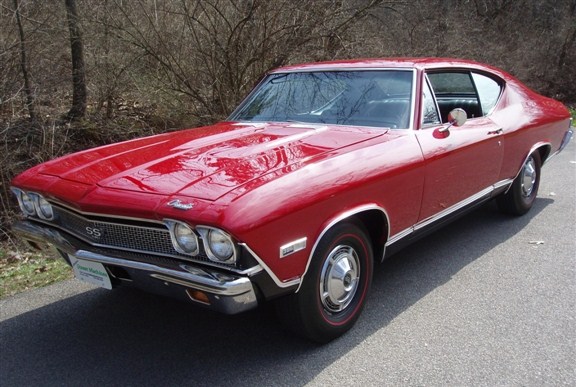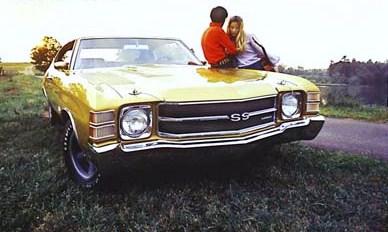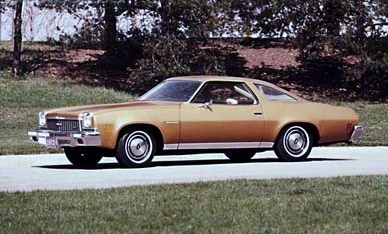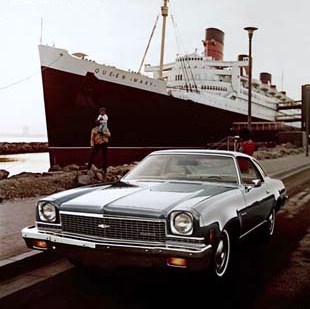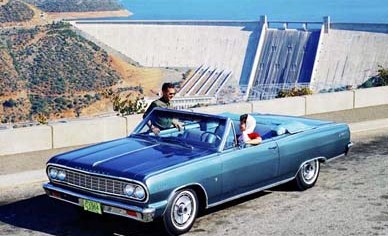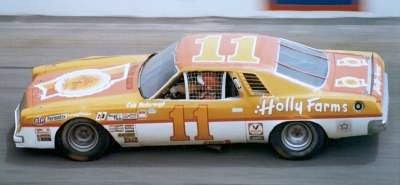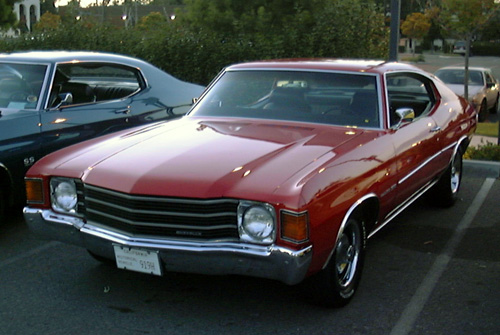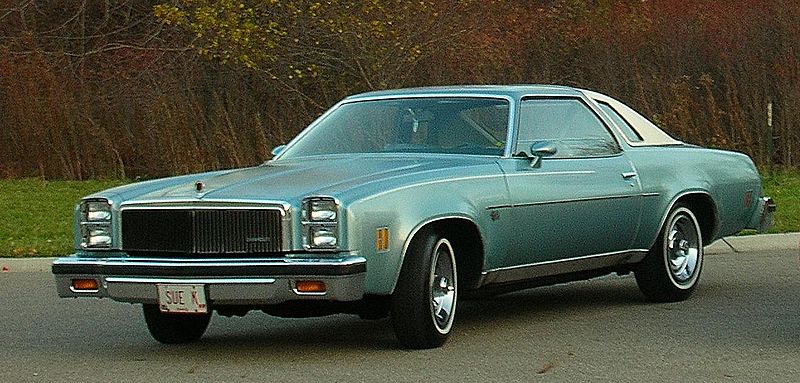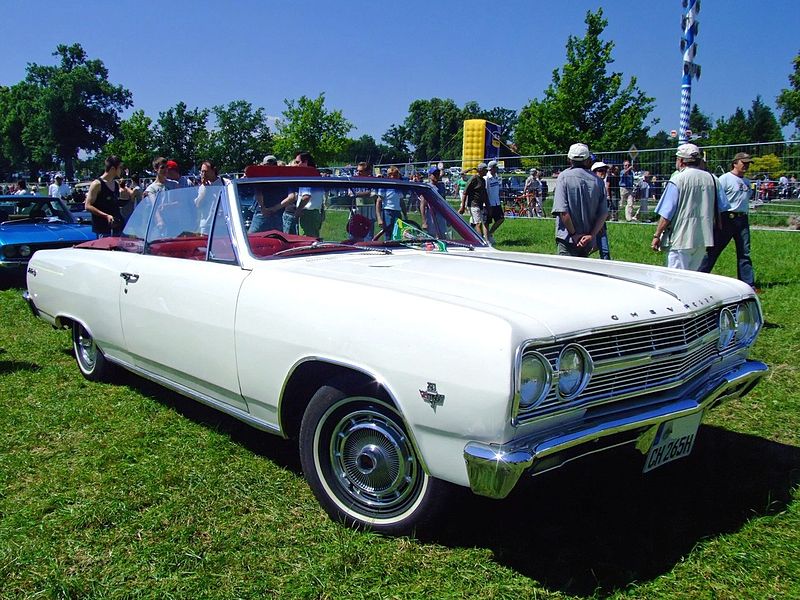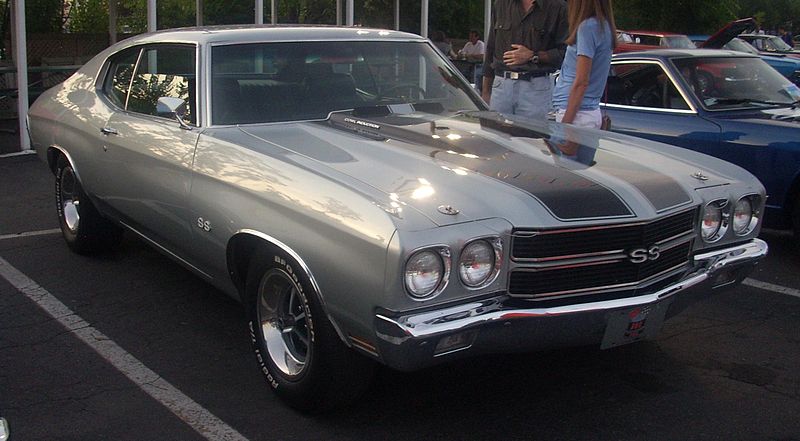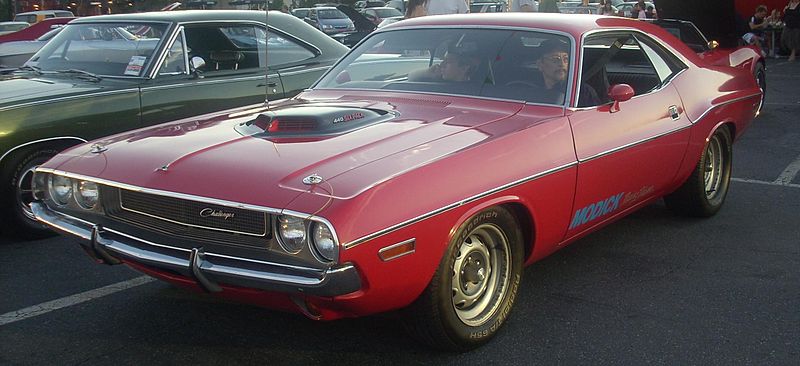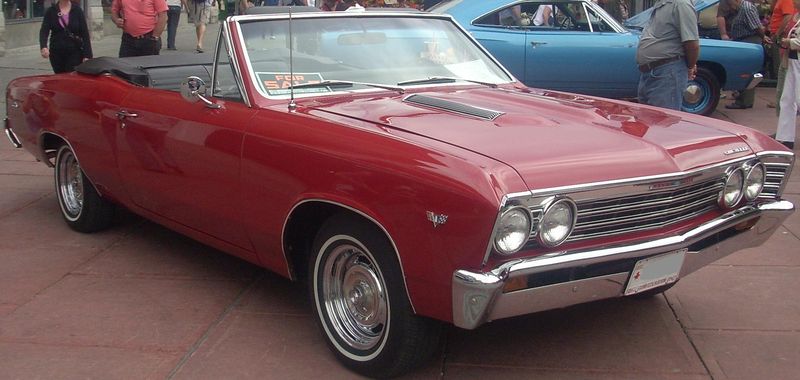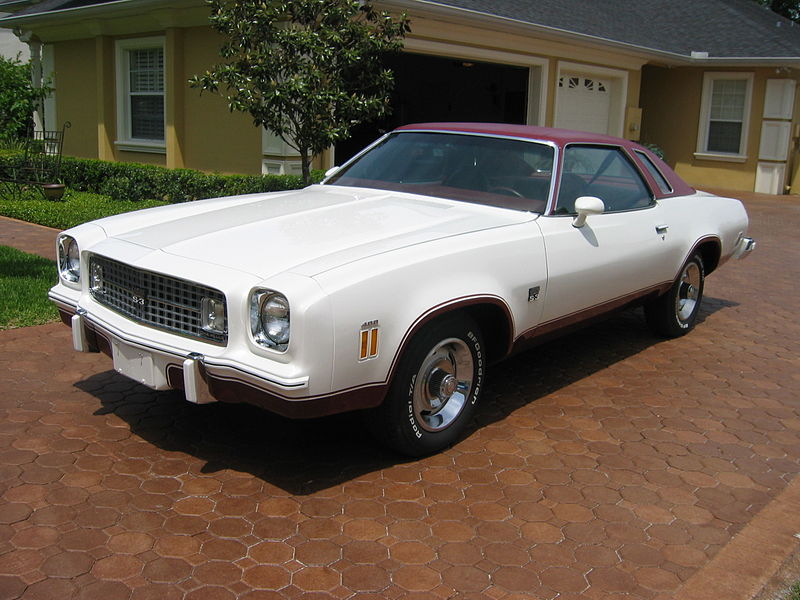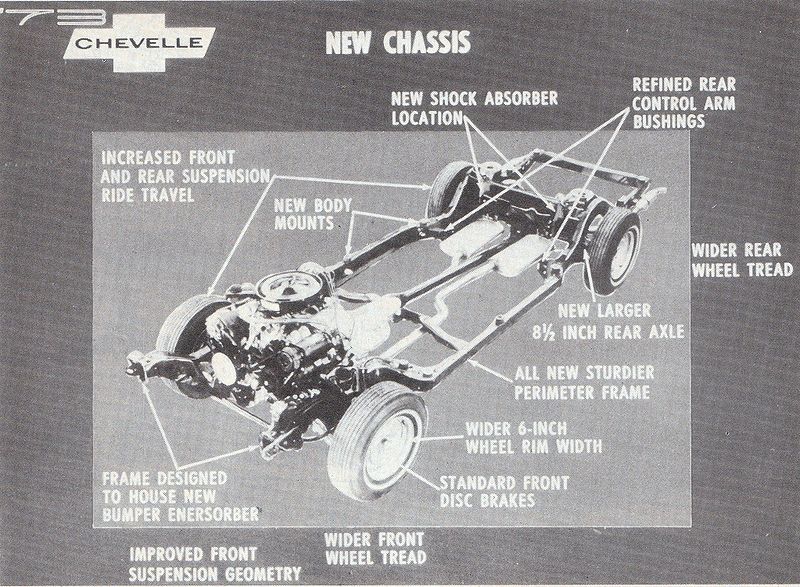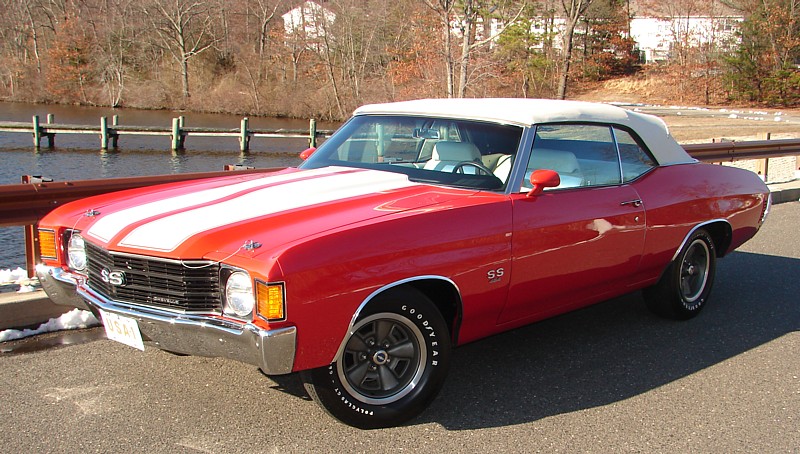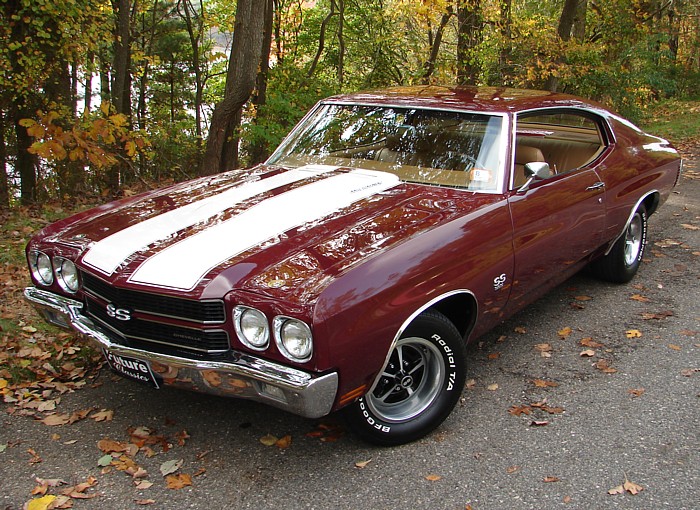Каталог статей
| Головна » Статті » Chevrolet » Chevrolet |
Chevrolet Chevelle
Chevrolet Chevelle 1964 Chevrolet Chevelle Malibu SS Convertible Manufacturer Chevrolet Division of General Motors Production 1963–1977 Model years 1964–1977 Successor Chevrolet Malibu Class Mid-size Layout FR layout Platform A-body  The Chevrolet Chevelle is a mid-sized automobile produced by the Chevrolet division of General Motors in three generations for the 1964 through 1977 model years. Part of the GM A-Body platform, the Chevelle was one of Chevrolet's most successful nameplates. Body styles include coupes, sedans, convertibles and station wagons. Super Sport versions were produced through the 1973 model year, and Lagunas from 1973 through 1976. After a three year absence, the El Camino was reintroduced as part of the new Chevelle lineup. The Chevelle also provided the platform for the Monte Carlo introduced in 1970. The Malibu, the top of the line model through 1972, replaced the Chevelle nameplate for the redesigned, downsized 1978 models.Contents [hide]
History First-generation 1964 Chevrolet Malibu SS Hardtop Coupe Production 1963–1967 Model years 1964–1967 Assembly Arlington, Texas, United States Atlanta, Georgia, United States Baltimore, Maryland, United States Flint, Michigan, United States Framingham, Massachusetts, United States Fremont, California, United States Kansas City, Kansas, United States Van Nuys, California, United States Oshawa, Ontario, Canada Sainte-Thérèse, Quebec, Canada Body style 2-door hardtop 2-door coupe 2-door convertible 2-door sedan 4-door sedan 4-door hardtop 4-door station wagon 2-door station wagon Engine 194 cu in (3.2 L) Inline-Six I6 230 cu in (3.8 L) Inline-Six I6 250 cu in (4.1 L) Inline-Six I6 283 cu in (4.6 L) Small-Block V8 327 cu in (5.4 L) Small-Block V8 396 cu in (6.5 L) Big-Block V8 Transmission 3-speed manual 4-speed manual 2-speed automatic 3-speed automatic Wheelbase 112 in (2845 mm) Curb weight 3256 (1476.9 kg) Related Pontiac Tempest Pontiac Le Mans, Buick Special, Buick Skylark, Oldsmobile F-85 Oldsmobile Cutlass Acadian Beaumont, Beaumont, Chevrolet El Camino
[edit] First generation (1964–1967) [edit] Overview The Chevelle was intended to compete with the Ford Fairlane, and to return to the Chevrolet lineup a model similar in size and concept to the popular 1955-57 models. Enthusiasts were quick to notice that the Chevelle’s 115-inch (2,900 mm) wheelbase was the same as that of the 1955-57 Chevy. Two-door hardtop coupes, and convertibles, four-door sedans, and four-door station wagons were offered throughout the entire run. In line with other Chevrolet series, the two-door hardtops were called Sport coupes. Four-door hardtops, dubbed Sport Sedans, were available (through 1972). A two-door station wagon was available in 1964 and 1965 in the base 300 series. Various wagons were sold with exclusive nameplates: Greenbrier, Concours, and Concours Estate. Six-cylinder and V-8 power was offered across the board. The Chevelle was the basis for the Beaumont, a re-trimmed model sold only in Canada by Pontiac dealers.
Chevelle SS 1965 Chevelle Malibu SS396 Hardtop Coupe The Chevelle SS represented Chevrolet's entry into the muscle car battle. Early 1964 and 1965 Chevelles had a Malibu SS badge on the rear quarter panel. Chevelles with the mid-1965 Z16 option priced at US$1,501 in 1965,[1] had the emblem on the front fender, as well as distinct in-house style numbers, 737 for the hardtop, 767 for the convertible;[2] The $162 Super Sport package was available on the upscale Malibu two-door hardtop and convertible models, the option added special exterior brightwork with SS emblems and the 14-inch full-disc wheel covers from the Impala SS. Inside was a vinyl bucket-seat interior that featured a floor console for models equipped with the optional Muncie aluminum four-speed-manual or Powerglide two-speed automatic instead of the standard three-speed manual. Malibu SS also got a four-gauge cluster in place of engine warning lights, and a dash-mounted tachometer was optional. The available 283-cubic-inch four-barrel V-8 engine rated at 220-horsepower was the same rating as the 1957 Chevy Power-Pak 283 engine.
While the 1964 Malibu SS may have recalled past glories, the future was available over at Pontiac. There, Chevelle’s Pontiac Tempest corporate cousin had a 389-cubic-inch V-8 to create the 325 horsepower (242 kW) Pontiac GTO, followed quickly by the 310-horse 330-cube-inch Oldsmobile Cutlass 442. That was all it took for Chevy to break GMs 326-cubic-inch ceiling for intermediate-car engines. Starting in mid-1964, the Chevelle could be ordered with the division’s 327-cubic-inch V-8, in either 250 or 300 hp (224 kW). Both used a four-barrel carb and 10.5:1 compression and could hold their own against 289 Ford Fairlane and 273 Plymouth Barracudas. But muscle fans would demand more, and get it. For 1965, Chevrolet also offered the 350-hp 327 V8 as Regular Production Option (RPO) L79. Still, for those "sensible” buyers, the Chevelle was appealing and Chevy built 294,160 this first year, including 76,860 SS models.[3] After 1965, the Malibu SS badging disappeared except for those sold in Canada. Only 201 Malibu SS396 big-block-equipped cars were produced in 1965.
The Chevelle SS 396 became a regular series of its own in 1966.(style numbers 817 and 867 that year),[4] was the high performance version and had its own line of engines and performance equipment. SS 396 coupes and convertibles used the same Malibu sport coupe and convertible bodies with reinforced frames and revised front suspension: higher-rate springs, recalibrated shocks, and thicker front stabilizer bar but with different exterior trim. They also had simulated hood scoops, red-stripe tires, and bright trim moldings. The performance engines available included 396 CID V8s – rated at 325 hp (242 kW), 350 hp (260 kW), and 375 hp (280 kW) respectively (the mid horsepower 396 was rated at 360 hp (270 kW) for 1966 only and 350 hp (260 kW) thereafter). The SS396 series lasted from 1966 through 1968 before being relegated to an option package. The 1966 and 1967 model years were the only 2 years of the 'strut back' 2-door sport coupe with its own style number, 17.[4] [edit] Z16 SS396
Only 200 regular production 1965 Z16 Chevelles were built at the Kansas City plant. The Z16 option included the convertible boxed frame, a narrowed rear axle and brake assemblies from the contemporary Impala, heavy-duty suspension, plus virtually all Chevelle comfort and convenience options. The Z16 standard big-block 396 Turbo-Jet V8 came only with the Muncie wide-ratio four-speed manual transmission. The rear panel of the Z16 had unique black and chrome trim which framed untrimmed Chevelle 300-style taillights (Malibu and Malibu SS models had bright metal lens trim).
The prototype Z16 Chevelle was built at the Baltimore plant. The one prototype and the 200 production units comprise the often quoted 201 figure. One convertible was reportedly special built for Chevy General Manager Semon "Bunkie" Knudsen but is understood to have been destroyed. This Z16 convertible supposedly surfaced in Art Astor's famous auto collection; it has been proven to be a fake.
[edit] New Body 1966–1967
1966 saw a complete restyle of the Chevelle on the previous frame that included smooth contours, a broad new grille and bumper treatment, and curved side windows. Bulging rear fender lines and a "flying buttress" roofline (tunneled into the "C" pillar) were highlights of the '66 hardtops, shared with other GM "A" body models. The new body reflected the "Coke bottle" body shape that became the fad for American cars in the mid-1960s. A hardtop-styled Sport Sedan joined the Malibu series. Chevelles continued in 300, 300 Deluxe, and Malibu trim. Available engines were a 327-cubic-inch V-8 instead of either of the sixes, or the mid-level option, a 220-horsepower 283-cubic-inch V-8. Judicious attention to the options list could add a tachometer, mag-style wheel covers, and sintered-metallic brakes. 1967 Chevelle SS396 Hardtop Coupe
The 1967 models got some styling tweaks that resulted in a longer, more straightforward appearance. Large taillamps went into a new rear end with standard backup lights. Otherwise, visible change was modest. "What you'll see inside," claimed the sales brochure for the 1967 Chevelle, "will probably bring on a severe compulsion to go driving." Front disc brakes were available on all models, and a new dual master cylinder brake system incorporated a warning light. An entire host of new safety equipment became standard, including a collapsable steering column[5] making the 1967 models safer cars. The SS396 continued as the only Super Sport model, in both Sport Coupe and Convertible body styles. The 375-horsepower 396-cubic-inch V-8 officially departed from the options list however 612 were still built. Buyers selected from no less than six transmissions: two three-speeds, four-speed, overdrive, and two automatics. The manual-shift feature of the Turbo Hydra-Matic transmission was touted in advertising. Options included Superlift air shock absorbers, Strato-ease headrests, and special instrumentation. Although Chevy's big news for 1967 was the introduction of the Camaro, Chevelle offered a more traditional sort of sportiness. Second-generation 1968 Chevrolet Chevelle SS396 Hardtop Coupe Production 1967–1972 Model years 1968–1972 Assembly Arlington, Texas, United States Atlanta, Georgia, United States Baltimore, Maryland, United States Flint, Michigan, United States Framingham, Massachusetts, United States Fremont, California, United States Kansas City, Kansas, United States Van Nuys, California, United States Oshawa, Ontario, Canada Sainte-Thérèse, Quebec, Canada Body style 2-door hardtop 2-door coupe 2-door convertible 2-door sedan 4-door sedan 4-door hardtop 4-door station wagon Engine 230 cu in (3.8 L) Inline-Six I6 250 cu in (4.1 L) Inline-Six I6 307 cu in (5 L) Small-Block V8 327 cu in (5.4 L) Small-Block V8 350 cu in (5.7 L) Small-Block V8 396 cu in (6.5 L) Big-Block V8 400 cu in (6.6 L) Small-Block V8 402 cu in (6.6 L) Big-Block V8 427 cu in (7 L) Big-Block V8 454 cu in (7.4 L) Big-Block V8 Transmission 3-speed manual 4-speed manual 2-speed automatic 3-speed automatic Wheelbase 112 in (2845 mm) Coupe 116 in (2997 mm) Sedan/Wagon Curb weight 3520 lbs (1600 kg) Related Chevrolet Monte Carlo Pontiac Tempest Pontiac Le Mans, Buick Special, Buick Skylark, Oldsmobile F-85 Oldsmobile Cutlass Acadian Beaumont, Beaumont, Chevrolet El Camino, GMC Sprint
[edit] Second generation (1968–1972) [edit] Overview The 1968 Chevelle got an all-new distinctly sculpted body with tapered front fenders and a rounded beltline. The car adopted a long-hood/short-deck profile with a high rear-quarter "kick-up". While all 1967 Chevelle models rode a 115-inch (2,900 mm) wheelbase, the 1968 coupes and convertibles now rode a sporty 112-inch (2,800 mm) wheelbase. The sedans and wagons turned to a 116-inch (2,900 mm) span. Tread width grew an inch front and rear. Hardtop coupes featured a semi-fastback, flowing roofline. Top-trim models (including the SS 396 and new luxury Concours) featured GM's new Hide-A-Way wiper system. Lesser Chevelles would get that change later. The Super Sport (SS 396 coupe and convertible) became series on its own. Chevrolet produced 60,499 SS 396 hardtops but only 2,286 convertibles. Black-accented Super Sports rode F70x14 red-stripe tires and carried a standard 325-horsepower 396-cubic-inch Turbo-Jet V-8 engine below the special twin-domed hood. 350 and 375-horsepower 396 engines could be substituted. The SS 396 Sport Coupe started at $2,899 - or $236 more than a comparable Malibu with its 307-cubic-inch V-8. All-vinyl bucket seats and a console were optional. The new Concours Sport Sedan focused on luxury, with special sound insulation, and a deep-padded instrument panel with simulated woodgrain accents and all-vinyl color-keyed interiors. Malibu gained a new Sport Sedan body style this year. The Concours Estate Wagon was one of four distinct Chevelle wagon models. A one year Nomad, Nomad Custom was offered. Regular Chevelle engines started with a 140 horsepower (100 kW) Turbo-Thrift six or the new 200 horsepower (150 kW) Turbo-Fire 307 V-8, but stretched to a 325 horsepower (242 kW) version of the 327-cubic-inch V-8. Manual transmission cars got GM's "Air Injection Reactor (A.I.R)" smog pump, which added complexity under the hood. New Federal safety-mandated equipment included side marker lights, as well as shoulder belts for outboard front seat occupants on cars built after December 1, 1967. [edit] Changes 1969–1972
1969 Chevelle SS396 Hardtop Coupe 1969 Chevelles were billed as "America's most popular mid-size car." They showed only minor changes for 1969, led by revised front-end styling. A single chrome bar connected quad headlights, and a slotted bumper held the parking lights. Taillight lenses were larger and more vertical, flowing into the quarter panels. Front vent windows began to fade away now that Astro Ventilation was sending outside air into several Chevelle models. The Chevelle lineup slimmed down to two series: 300 Deluxe and Malibu. No longer a series of its own, the SS 396 turned into a $347.60 option package for any two-door model. That meant not just a convertible or hardtop Sport Coupe, but even the pillared coupe in the lower-rent 300 Deluxe series. A very few 300 Deluxe SS396-optioned pillared coupes were built, and they are solid gold for collectors. The Super Sport included a 325-horsepower 396-cubic-inch V-8 beneath a double-domed hood, along with a black-out grille displaying an SS emblem and a black rear panel. More potent editions of the 396 engine also made the options list, developing 350 or 375 horsepower (280 kW). A few hundred Chevelles even managed to acquire a 427-cubic-inch V-8, ordinarily installed only in full-size models. Chevelle station wagons came in three levels: Concours, Nomad, and Greenbrier—the last a badge formerly used on the Corvair van. A new dual-action tailgate operated either in the traditional manner or as a panel-type door. Wagons stretched 208 inches (5,300 mm) overall versus 197 inches (5,000 mm) for coupes. New round instrument pods replaced the former linear layout. Chevelle options included headlight washers, power windows and locks, and a rear defroster. Chevy's midsize production rose this year, with Malibus far more popular than their less-costly mates. Fewer than seven percent of Malibus had a six-cylinder engine, while more than 86,000 got an SS 396 option. All '69 Chevelles got a new locking steering column one year ahead of the Federal requirement, and headrests required for all cars sold in the U.S. after January 1, 1969.
In 1970, sheetmetal revisions gave the bodies a more squared-up stance, and interiors were redesigned, too. The 1970 Chevelles came in Sport Coupe, Sport Sedan, convertible, and four-door sedan—along with a pair of Super Sport upgrades. The SS option was now limited to the Malibu 2-door Sport Coupe and convertible. Later in the model year came a basic model, essentially a revival of the former 300 Deluxe; it was offered only as a Sport Coupe and sedan. New options included power door locks and a stalk-mounted wiper control. Engine choices ranged from the standard 155 horsepower (116 kW) six-cylinder and 200-horsepower 307-cubic-inch V-8, to a pair of 350 V-8s and a pair of 402 ( 396 ). Bigger engines became available as regular production options, resulting in the addition of an SS454 option.
The SS 396 Chevelle included a 350 horsepower (260 kW) Turbo-Jet 396 V-8, special suspension, "power dome" hood, black-accented grille, resilient rear-bumper insert, and wide-oval tires on sport wheels. Though a 375 horsepower (280 kW) upgrade was available, few were sold—primarily because the added cost brought the total too close to the SS 454. The 454-cubic-inch V-8, offering 360 horsepower (270 kW) in standard form but a whopping 450 horses in solid-lifter, high-compression, LS-6 guise. The latter made a Chevelle one of the quickest muscle cars ever built. "You can make our tough one even tougher," the brochure explained, by adding Cowl Induction to either SS model. Step on the gas, and a scoop opened "to shoot an extra breath of cool air into the engine air intake....like second wind to a distance runner." Functional hood lock pins completed the SS package. The 454 cu in (7.4 L) LS5 V8 was rated at 360 hp (270 kW). The LS6, with 450 hp (340 kW) and 500 ft·lbf (680 N·m) of torque, would provide 1⁄4 mi (400 m) strip performances in the low to mid-13 second range at 105–108 mph (169–174 km/h). The ZL1 and L88 427s both were rated at 430 hp (320 kW), but actually produced well over 500 hp (373 kW) in stock configurations. They were "race only" engines and very very few were ever installed in production cars. Most were ordered by racers who had factory connections or sold over the counter parts.
The 1971 Chevelles got fresh front-end styling that included large Power-Beam single-unit headlights, a reworked grille and bumper, and integral park/signal/marker lights. New dual round taillights were integral with the back bumper. Because SS models suffered heavy insurance surcharges, Chevrolet introduced the "Heavy Chevy" at midyear available with any V-8 engine except the 454, which was exclusive to SS models. For 1971, the base Chevelle SS engine was a two-barrel 350-cubic-inch V8 rated at 245 gross (165 net) horsepower. Optionally available was a four-barrel carbureted version of the 350 V8 rated at 275 gross (200 net) horsepower. The big block engines of previous years were now optional, including the 402 V8 rated at 300 gross (270 net) horsepower; and LS-5 454 V8 with 365 gross and 285 net horsepower. Chevrolet specifications for 1971 included both "gross" and "net" horsepower figures for all engines. The SS option could be ordered with any optional V8 and became more of a dress-up option than a performance option. GM mandated all divisions design their engines to run on lower-octane regular, low-lead or unleaded gasoline. To permit usage of the lower-octane fuels, all engines featured low compression ratios (9:1 and lower; well below the 10.25-11.25:1 range on high-performance engines of 1970 and earlier). This move reduced horsepower ratings on the big-block engines to 300 for the 402 cubic-inch V8 but surprisingly, the LS-5 454 option got an "advertised" five-horsepower increase to 365. The LS-6 454 option, which was originally announced as a regular production option on the Chevelle SS for 1971, was dropped early in the model year and no official records indicate that any 1971 Chevelles were assembled with the LS-6 engine
1972 Chevelles wore single-unit parking/side marker lights on their front fenders, outside of a revised twin-bar grille. All Malibus had concealed wipers. Super Sport equipment could now be ordered with any V-8 engine, including the base 307-cubic-inch version. The 1972 Chevelle series had wide enough appeal to qualify as America's second-best-selling car. Base versions again included a four-model wagon series. Upscale versions were Malibus including the convertible models. More than 24,000 Malibu Sport Sedans were built, with a standard 307-cubic-inch V-8 rated at 130 (net) horsepower. With that V-8, the Malibu Sport Coupe was the top seller by far starting at $2,923. The six-cylinder version ran $90 less. Powertrain options included the 175-horsepower 350-cubic-inch V-8 and 240-horsepower 402-cubic-inch (still known as a 396), as well as a 454 that managed to put out 270 horsepower (200 kW) under the net rating system. Chevelles sold in California could not get the 307 V-8 but carried a 350-cubic-inch engine instead. Through the 1970s, California cars often had different powertrains than those marketed in states with less-stringent emissions regulations. Super Sport equipment could now be ordered with any V-8 engine, including the base 307-cubic-inch version. The 1972 Chevelle SS had a top engine rated at 270 net hp (201 kW) conforming with GM's decree that all engines were to be rated at their net engine ratings. Despite the lower rating there was no evidence that power had actually changed on production cars of that year. All other engines on the SS roster were unchanged from 1971. Chevelle wagons measured 10 inches (250 mm) shorter than full-size wagons and weighed about half a ton less, but sold much slower. Americans obviously still liked their big cars. Model-year output totaled 49,352 Chevelles and 290,008 Malibus—plus 54,335 station wagons. [edit]
Retired race car driver Don Yenko, (at the time making a living as a Chevrolet dealer), developed his own line of signature Chevelles, along with his own models of Camaros and Novas, which became the Yenko Super Cars. At the time, the largest engine being installed in Chevelle SS's was the 396 cid V8. Yenko decided to equip his acquired models with the Chevrolet 427 cid V8. While being an extremely limited edition of Chevelles, they nonetheless proved very popular among Chevy lovers across the country. Today at auction, the Yenko Super Cars can bring as much as $2.2 million. Prior to 1970, GM had a restriction stating no mid-size car could have an engine with a displacement over 400 cu in (6.6 L). Don Yenko discovered a way to get around that edict. Don used the Central Office Production Order system, which normally filled special-equipment fleet orders, to create a special COPO that included the L72 427 cubic inch 425 hp (317 kW) engine and the needed drive train upgrades. A few other dealers ordered the package Yenko created and sold them as their own supercars. (Berger, Sunico, etc.) Third generation 1973 Chevrolet Chevelle Malibu Colonnade Coupe Production 1972–1977 Model years 1973–1977 Assembly Arlington, Texas, United States Atlanta, Georgia, United States Baltimore, Maryland, United States Flint, Michigan, United States Framingham, Massachusetts, United States Fremont, California, United States Kansas City, Kansas, United States Van Nuys, California, United States Oshawa, Ontario, Canada Sainte-Thérèse, Quebec, Canada Body style 2-door coupe 4-door sedan 4-door station wagon Engine 250 cu in (4.1 L) Inline-Six I6 305 cu in (5 L) Small-Block V8 307 cu in (5 L) Small-Block V8 350 cu in (5.7 L) Small-Block V8 400 cu in (6.6 L) Small-Block V8 454 cu in (7.4 L) Big-Block V8 Transmission 3-speed manual 4-speed manual 3-speed automatic Wheelbase 112 in (2845 mm) Coupe 116 in (2997 mm) Sedan/Wagon Related Chevrolet Monte Carlo Pontiac Le Mans, Pontiac Grand Am, Pontiac Grand Prix, Buick Century, Buick Regal, Oldsmobile Cutlass, Chevrolet El Camino, GMC Sprint
[edit] Third generation (1973–1977) [edit] Overview The 1973–'77 Chevelles accounted for nearly 1.7 million sales in one of the most unsettling periods the automotive industry ever faced. Little changed in design during the five years they were built. When these Chevrolet intermediates were retired, though, it had to be obvious to anyone who bothered to notice that there would never be cars quite like them again. Surprisingly large and comfortable, surviving Chevelles of this era bring back memories of how enjoyable V-8-powered, rear-drive 1970s GM cars could be. That is, if you can find a nice one today. Pristine examples of the 28,647 1973 Malibu SS Coupes and wagons, 42,941 1973 Laguna Coupes, and 38,790 1974–1976 Laguna Type S-3 Coupes are difficult to find, which is a shame now that fuel is plentiful, and the 55 mph (89 km/h) national speed limit has been consigned to history.[6]
The most extensive redesign in its 10-year history marked the 1973 Chevelle, and with it marked the end of hardtops as we knew them. The newly-named "Colonnade Hardtop" featured a semi-fastback roofline, frameless door glass and fixed, styled "B" pillars, structurally strong enough to contribute to occupent safety of a roll-over type accident. GM had anticipated Federal roll-over safety standards that ironically didn't materialize. Distinctive rear quarter glass on 2-door coupes and new side windows with styled center pillars were featured on 4-door models. Rear windows on coupes no longer opened. In addition to the new roofline, front and rear ends looked markedly different this year as 1973 was the year of the federally-mandated 5 mph (8.0 km/h) front bumper, adding to the car's length. Additional new body features were an acoustical double-panel roof, tighter-fitting glass and flush style outside door handles. Wheelbase dimensions were retained; a sporty 112 inches (2,800 mm) for coupes and 116 inches (2,900 mm) for sedans and station wagons, but bodies were five inches (127 mm) longer and an inch wider with a 1-inch (25 mm) wider wheel track. The station wagon, available in 6 or 9 passenger seating, featured a new counterbalanced liftgate which allowed for easier entry and loading up to 85 cubic feet.[7]
[edit] New chassis
The chassis design was as new as the bodies - with an all-new, sturdier perimeter frame, new chassis/body mounts, larger 8½ inch rear axle, wider 6-inch wheel rim width, refined rear control arm bushings, increased front and rear suspension travel, new shock absorber location, and improved front suspension geometry[9] - The left wheel was adjusted to have slightly more positive camber than the right which resulted in a more uniform and stable steering feel on high-crown road surfaces while maintaining excellent freeway cruise stability. Clearances for spring travel were also improved for a smoother ride over all types of surfaces; the coil springs at each wheel were computer-selected to match the individual car's weight. Front disc brakes were now standard on all '73 Chevelles. John Z. DeLorean, Chevrolet's dynamic general manager during the design phase of the new Chevelles, left just as they were being announced. He departed in late September 1972 to start a brief stint as vice president of General Motors's Car and Truck Group. DeLorean left the new Chevelle an important legacy, though. He and Alex Mair, then Chevrolet's chief engineer, championed great handling. Like many new Chevrolet models of the era, the new Chevelles would be exceptional drivers' cars.[6]
Five power teams were available for 1973 Chevelle models; the 250 inline-six and 307 2-barrel V8 both rated at 110 hp (82 kW) were std. engines on Deluxe and Malibu. The 350 2-barrel V8 of 145 hp (108 kW) was the base Laguna engine. Options for any Chevelle included a 350 4-barrel V8 of 175 hp (130 kW) and a 454 4-barrel V8 rated at 250 hp (186 kW). Hardened engine valve seats and hydraulic camshafts made these engines reliable for many miles, and allowed them to accept the increasingly popular unleaded regular gasoline. 3 speed manual transmission was standard; 4 speed manual and Turbo Hydra-Matic 3 speed automatic were optional. Crossflow radiators and coolant reservoirs that prevented air from entering the system prevented overheating.[10] [edit] Revised model lineup
1973 Chevelle Malibu SS Colonnade Coupe Malibu and the newly named Deluxe series base model featured the new 5 mph (8.0 km/h) bumper system with a large chrome front bumper and a chrome rear bumper. Malibu series interiors included cloth and vinyl or all vinyl seat trim and deep-twist carpeting. Deluxe series interiors featured cloth and vinyl or knit vinyl seat trim. Floor coverings were color-keyed in vinyl-coated rubber. The SS was now a trim option limited to the mid-level Malibu series. Shoppers could even get an SS station wagon this year - with the option of a 454-cubic-inch V-8 engine, no less—but the mix of sport and utilitarian wagon virtues would last only a single season. Included was a black grill with SS emblem, lower bodyside and wheel opening striping, bright roof drip moldings, color-keyed dual sport mirrors, black taillight bezels, SS fender and rear panel emblems, special front and rear stabilizer bars, 14x7 inch rally wheels, 70-series raised white lettered tires, special instrumentation and SS interior emblems.[10] The SS option required an available 350 or 454 V8 with 4-speed or Turbo Hydra-Matic transmission. 1973 Chevelle Malibu SS Station Wagon Chevrolet honored California beach resorts once again by naming the top Chevelle series Laguna with the Malibu taking the middle spot while the base series was called simply Deluxe. In addition to the standard 350 2 barrel V8, Laguna models featured specific front and rear styling including a body-colored urethane front end concealing the new 5 mph bumper system. On minor impact the urethane nose cone, backed up by shock- absorbing cylinders, deflects and rebounds; Laguna models also featured a specific diecast chrome grille with bowtie emblem, a body-colored (steel) rear bumper, front and rear bumper rub strips, bright roof drip moldings, bright wheel opening moldings, chrome taillight bezels, full wheel covers, and Laguna fender nameplates. Two Laguna station wagons were introduced, including a Laguna Estate. Laguna interiors were pattern cloth and vinyl or optional breathable all-vinyl upholstery, distinctive door trim with map pockets, deep-twist carpeting, woodgrain vinyl accents, and Laguna nameplates.[10] Consumers continued to snap up Chevelles: 327,631 of them in the 1973 model year, plus 59,108 station wagons. The Malibu versions of the Chevelle continued to sell best by a wide margin, but the costlier Laguna coupe and sedan made a respectable showing, with 56,036 going to customers. Super Sport options went on 28,647 Chevelles of which 2500 held the big 454-cubic-inch engine. The SS option was dropped at the end of the model year.[11] [edit] Changes 1974–1977 1974 Chevelle Laguna S-3 Coupe Yearly design changes to the front and rear mark the aesthetic differences as in previous years. The Chevelles were top sellers for GM as was the Oldsmobile Cutlass, which used the same corporate A-body platform. 1974 Chevelles featured new grilles, new taillights and 5 mph (8.0 km/h) rear bumpers (in addition to the 5 mph (8.0 km/h) front bumper added in '73) The Laguna name had debuted on the 1973 Chevelle as the top-line series in all body-styles, but the 1974 Laguna Type S-3 came only as a coupe, which combined Laguna luxury with the superior road manners of the SS which it replaced. Handling was further enhanced with the addition of new GR70-15 radial-ply tires. The new Laguna S-3 sported the urethane front end with a revised grill and new parking lamps, augmented at the rear by new taillights. A federally-mandated 5 mph (8.0 km/h) chrome rear bumper replaced the body-colored steel 2.5 mph (4.0 km/h) version from '73. Standard equipment included a console, a vinyl roof, opera-type vertical rear quarter windows which could be covered with horizontal ribs for a few dollars extra; body side striping, Laguna S3 badging, rally wheels, 4 spoke steering wheel as well as firmer shocks/springs, a front stabilizer bar, and fat HR70x15 tires on Rally wheels. Front occupants rode in swivel bucket seats, and the driver faced a six-dial instrument cluster. Production totaled 15,792 cars, with prices starting at $3,723 - but with plenty of options to send the bottom line past $5,000. Engine offerings included a standard 145 horsepower (108 kW) 350 two-barrel V8, with optional powerplants including a 150 horsepower (110 kW) 400 two-barrel V8, 180 horsepower (130 kW) 400 four-barrel V8 and 230 horsepower (170 kW) 454 four-barrel V8, except in California where a 155 horsepower (116 kW) 350 four-barrel V8 was standard and the 400 and 454 engines were optional. The 454 was available with the Turbo Hydra-Matic automatic 400 or Muncie 4 speed manual transmissions. 3-point seat belts with integrated shoulder belts were introduced as on all Chevrolet models. With the Laguna nameplate now bearing the sporty model in the Chevelle line, the top-line series for 1974 was the new Malibu Classic series, offered in sedan, coupe and station wagon models. Unlike the 1973 Laguna, the Malibu Classic used the same front end and chrome bumper as the lesser (Malibu) models, but the vertical rear quarter windows and a spring-loaded hood ornament were featured. Inside, the Malibu Classic featured luxurious interiors with notchback bench seats upholstered in cloth or vinyl, carpeted door panels and woodgrain instrument panel trim. Optional on Malibu Classic coupes were swivel bucket seats (with console) in cloth or vinyl. The base Deluxe series was dropped for 1974, making the Malibu the base model. Base engines were the 250-cubic-inch six and the 350-cubic-inch V-8. 1975 Chevelle Malibu Coupe 1975 Chevelle Laguna S-3 Coupe For 1975 although the basic body styling was unaltered, the Colonnade designation was dropped. The lineup was marked by fresh front and rear styling including a vertical grid-patterned grille and new bright trim around the headlights were highlights. Rectangular taillights sat flush with the body surface, connected by a brushed chrome panel. Malibu Classic coupes had distinctive opera windows. Landau coupes came with a vinyl roof, full wheel covers, whitewall tires, color-keyed body striping, and dual sport mirrors. Engines ranged from the standard 250-cubic-inch six and 350-cubic-inch 2-barrel V-8 to V-8 options of 400 and 454-cubic-inch size, the last with a 235-horsepower rating. Variable-ratio power steering was now standard with V-8 models, and all 1975 models rode steel-belted radial tires. A new "Chevrolet Efficiency System" introduced a High-Energy Ignition (HEI). This electronic ignition system provided minimal maintenance and increased power. Speedometers were now calibrated in both miles per hour and kilometers per hour. Following its debut as a 1974 model, the sporty Laguna Type S-3 left the lineup briefly, then reappeared in January 1975. This time, it wore a rakishly slanted, urethane-covered aero-style nose designed for NASCAR (first use on a Chevrolet vehicle - later to show up on the 1983-88 Monte Carlo SS), louvered opera windows, and could be ordered with a vinyl half-roof. The 454 engine option was available for the first half of the model year after which the 400 engine became the top engine. Options included an Econominder gauge package, affirming again that the age of muscle was long gone. 1976 Chevelles earned a billing as "a size whose time has come." Malibu Classics adopted a diamond-pattern grille and stacked rectangular headlights, while regular Malibus kept a single-light setup and plainer grillwork. Three V-8s were available: a new 305-cubic-inch version rated at 140 horsepower (100 kW), a 165-horsepower 350-cubic-inch, and a 400-cubic-inch engine that developed 175 horses. Options included the Econominder gauge package. In its third and final season, the 1976 Laguna Type S-3 was little changed. It again featured quarter-window louvers and a sloped, body-color urethane front end. Lagunas shared their round-gauge instrument panel with the Chevrolet Monte Carlo, and could be ordred with a four-spoke sport steering wheel as well as swivel front bucket seats and a center console. Lesser models made do with a more conventional dashboard and a linear-readout speedometer. Production of the Laguna edged up to 9,100 cars as the base price went to $4,621. 1977 Chevelle Malibu Classic Coupe The 1977 Chevelles got new grilles. The lineup consisted of Malibu and Malibu Classic models in coupe, sedan, and station wagon body styles. Estate Wagons and the Laguna Type S-3 were gone. Malibu Classics, again the top model, switched to a vertical grille pattern and six-section taillights but kept their twin stacked headlights and stand-up hood ornament. Malibu grilles changed little. Fewer engine selections were available though the engines that remained gained a few horses. In standard form, Chevelles had a 250-cubic-inch six-cylinder engine or a 145 horsepower (108 kW), 305-cubic-inch V-8. The sole option beyond that was a 170 horsepower (130 kW), four-barrel 350-cubic-inch V-8 (this engine was standard in the Malibu Classic station wagon) Malibu Classics had a luxurious cloth/vinyl split-bench front seat, color-keyed steering wheel, and woodgrain-accented instrument panel. Malibu options included a $46 Exterior Decor group, $54 tinted glass, and $33 full wheel covers. A total of 37,215 Malibu Classic Landau coupes were produced, as opposed to 73,739 Malibu Classic coupes and 28,793 Malibu coupes. In four-door sedan form, too, the Malibu Classics outsold base models by a substantial margin. The 350 V8 was the top engine. A Chevelle SE (special edition) was available and provided front and rear spoilers, turbine II wheels, F60x15 tires, special graphics and decals, quarter window trim, front and rear sway bars, F41 sport suspension and a deluxe interior. Three colors were available. 50 of these rare cars were built.When GM downsized its intermediate models for 1978, the Chevelle name was dropped. Malibu became the nameplate for all models. [edit] Reviews Speed and Supercar magazine said in a June 1973 "Street Test": "Chevy gets it right on." "Enough is plenty, that's how we feel about the 350 Laguna. "...We couldn't pass up the opportunity to tell you what a groovy all around car it is even if it can't smoke the quarter-mile in 13 seconds. And what car in '73 can." "It's not overpowering but it's enough - and so comfortable that the editor bought the car." "The Laguna is the type of car you want to own for fast, comfortable transportation in quiet luxury."[12] Motor Trend - 1973 Buyers Guide said: "Chevrolet is fielding an all-new intermediate Chevelle series at a time when competitive lines from Ford and Chrysler are one or more years old...when you look at what the stylists have done with what we used to call the pillar coupe, you might want to rush out and buy some stock in General Motors." Motor Trend said: "The Grand Am and the Laguna are large "small" cars. Nimble, quick and responsive." "The cleanly styled Laguna has a lot to recommend it. The car has a very tight feeling, a by-product of the heavily ribbed underbody and double paneled roof. Strongly in the Laguna's favor is the intergrated, body-colored urethane bumper-front end. It's a lot better looking out-front than the big bumper approach." Car and Driver said: "Directional stability is so strong on the highway that the Laguna seems locked on some guidance-beam radiated from your destination." "The Laguna's urethane nose cap allows the front end to be flat and free of gaps in this day of jutting bumpers; it's block-cut fenders are chauvinistically masculine, and no sheet metal is wasted cloaking its tires from view...so the Laguna looks like it could bowl over most of the cars on the road." [edit] NASCAR Cale Yarborough's #11 Chevelle Laguna The third generation Chevelle was an extensively used body style in NASCAR competition from 1973 to 1977. The Chevelle Laguna in particular was extremely successful allowing Cale Yarborough to win 34 races and earn the first two of three consecutive Grand National championships. Considered a limited edition model by NASCAR, the Laguna S-3 was ineligible for competition following the 1977 season. Motor Trend said in 1973: "While neither Chevrolet or Pontiac are back in racing, the new crop intermediates out of GM's styling studios are curiously aerodynamic. They are also curiously competing on the NASCAR circuit tracks, and selling as fast as they can be hauled to the dealerships." October 21, 1973: American 500-Benny Parsons pits for repairs after an early crash. The help of several teams allow him to get back into the race and finish 28th. Parsons and his Chevelle hold on to win the NASCAR Winston Cup Grand National championship. Parsons took the points lead with a third-place finish at Talladega Speedway in early May and never gave up the lead. He held off a late rally by Cale Yarborough to win by only 67.15 points. August 1976: Cale Yarborough drove his #11 Junior Johnson/Holly Farms Chevelle to the 1976 NASCAR Winston Cup Grand National championship. Yarborough won nine races along the way to the first of three consecutive titles. He finished last in the Daytona 500, but assumed command of the points chase in August. Yarborough beat Richard Petty by 195 points. February 20, 1977: Daytona 500-Cale Yarborough Chevelle pulls away from Benny Parsons Chevelle in the final laps to win in his second Daytona 500. Cale Yarborough was running at the finish in all 30 NASCAR Winston Cup races as he dominated the 1977 season to wrap up his second consecutive title. Yarborough won nine races in 30 starts in his #11 Chevelle and finished 386 points ahead of runner-up Richard Petty.[13] | |
| Переглядів: 32829 | Коментарі: 4 | Рейтинг: 0.0/0 |
| Всього коментарів: 3 | ||||
| ||||

